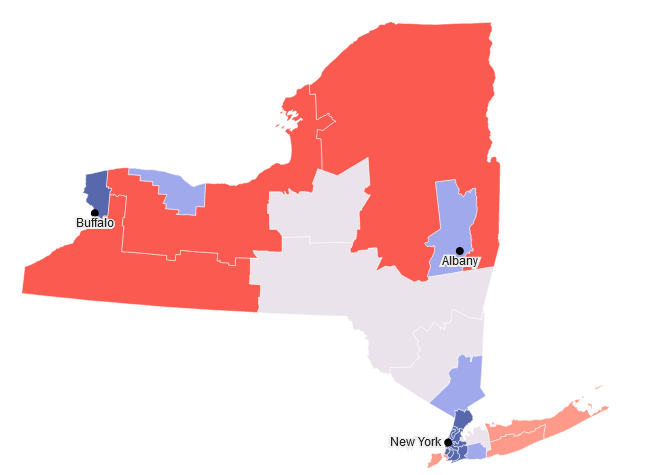After months for a long-awaited decision, the New York Court of Appeals in a 4-3 vote has ruled that the congressional lines for New York must be redrawn by the Independent Redistricting Commission (IRC) ahead of the 2024 elections.
The development is the latest in the redistricting epoch in New York, as the process was one of the most eventful and controversial of almost any state’s process last year.
After the 2020 Census, all states entered the redistricting process to alter congressional and state legislative lines to reflect population shifts. Some states’ processes are controlled entirely by the legislatures, while other states have entirely independent or bipartisan commissions that handle the maps. Other states have mixes of the two, while some states are at-large districts that do not require the process.
New York finds itself squarely in the center of that Venn Diagram, as the IRC is a feature of the state’s redistricting process, but the political parties still have a decent amount of leverage.
New York’s IRC was one of the hallmarks of Governor Andrew Cuomo’s (D) second term, in that voters approved a 2014 constitutional amendment to establish a ten-member panel to oversee the map-drawing and redistricting processes. Two panelists are appointed by the State Senate Majority Leader and Temporary President, two are appointed by the Senate Minority Leader, two are appointed by the Speaker of the Assembly, and two are appointed by the Assembly Minority Leader.
The final two panelists are then appointed by the eight appointees from the party leaders. Neither are permitted to have been registered with either party for at least five years before consideration.
Once assembled, the commission must hold public hearings on all relevant data and drafts relating to the process of redistricting. The commission then submits their plans to the legislature for approval.
When the proposition was conceived in 2014, it was done under a time of split-control government in New York. While Democrats had a lock on the Assembly – they have since the 1960s – and they controlled the governor’s office, Republicans held the Senate. While it didn’t change the nature of the appointments, it did change the nature of legislative approval, as the options were only relegated to passing the map, referring the map back to the commission- where minimal changes might have occurred – or experiencing legislative gridlock, undermining the purpose of the commission.
Republicans enjoyed control of the State Senate for much of the 20th Century, from 1939 until 2018, with gaps in 1965, 2009, and 2010. When Democrats solidified a majority in the chamber, the need for consulting with the minority party was tossed, allowing Democrats free reign to approve or deny the panel’s maps.
Under state law, the legislature can draw their own maps after rejecting the commission’s first two proposals. The commission submitted two maps in its first proposal, with one skewed towards Democrats and one towards Republicans. After the legislature rejected the proposals, the commission could not agree on a second-round proposal, handing control of redistricting to the legislature by default.
The legislature’s proposal was quickly seen as one of the most – if not the most – gerrymandered map in the United States at the time. While removing three red-leaning seats, the proposal added five Democratic-leaning seats.
The redistricting tracker on FiveThirtyEight is still online, although it is not being updated. The maps also display the partisan lean for each district, calculated by dividing the state’s overall partisan lean by the district’s most recent electoral result. The higher the partisan lean, the more favorable to one party it grows and the less competitive it becomes. Generally, a partisan lean of five points or under is seen as healthily competitive. While a party could win districts above that lean, it becomes considerably more difficult due to party fundamentals, down ballot energy, and the regularly-shifting political environments.

The gerrymander saw New York’s First Congressional District shift from a lean of R+10 to one of D+6. The district was represented by Lee Zeldin (R-Shirley) from 2015 to 2023 and is now represented by Nick LaLota (R).
The gerrymander also saw the Staten Island-based 13th District go from a lean of R+13 to D+7.
Perhaps the most questionable redraw was that of the north shore-based Third, previously represented by Tom Suozzi (D-Glen Cove). The proposal sought to draw the district from Setauket, across northern Nassau and Queens, up to Westchester County, all while taking in the thin shoreline of the Bronx along the East River. The lean went from D+6 to D+10.

The map was so egregiously drawn that Steuben County Judge Patrick McAllister ruled the map was a partisan gerrymander. The decision was appealed to the State Court of Appeals, who upheld the ruling. In typical judicial practice, when a map is rejected by a court, the body or panel who drew it usually has one last chance to rectify it. The logic here is that the body responsible for the map can create a quicker and more viable solution than the courts would. This exact scenario unfolded in Maryland the same year; when a Democratic gerrymander was struck down, the legislature took advantage of the window to pass a fairer map.
New York Democrats did not take the same offer, instead submitting revisions to the court-appointed special master, Jonathan Cervas. Cervas’ map added one highly competitive district, while keeping the nature of most existing seats intact. The lines did, however, see three Democratic seats fall under more competitive lines, but not overwhelmingly so. Two of these seats were flipped by Republicans in 2022, the 4th District by Anthony D’Esposito (R-Island Park) and the 17th District by Mike Lawler (R). The Twenty-Fifth District, a Rochester-based seat, was decided by a single-digit margin, but ultimately saw incumbent Joe Morelle (D) win re-election.
The latest 4-3 ruling from the Court of Appeals insists that the Independent Redistricting Commission has sole authority over the drawing of the congressional lines, as stipulated by the 2014 proposition.
“The Constitution demands that process, not districts drawn by courts,” said Chief Judge Rowan Wilson in his majority opinion. “Nevertheless, the IRC failed to discharge its constitutional duty. That dereliction is undisputed.”
Rowan was appointed by Governor Kathy Hochul (D) earlier this year after Democrats in the Senate refused her initial nominee Hector LaSalle a floor vote in a historic reversal of typical Senate procedure regarding judicial nominees. LaSalle was deemed “too conservative” for the state’s highest court. After a suit brought on by Senator Anthony Palumbo (R-New Suffolk), LaSalle was rejected by the Senate, paving the way for Rowan to ascend to the position of Chief Judge.
The Messenger reached out to local members of the state legislature. Senator Monica Martinez (D-Brentwood), of the Fourth District, is a member of the majority party who might potentially oversee the redistricting process again.
“I am respectful of the Judicial branch’s discretion in this matter,” says Martinez. “Their decision underscores the importance of upholding the principles of fair representation. Once the Commission submits the new maps to the legislature for approval, I will do my part and thoroughly review them. It is crucial the Commission works diligently to produce a fair and equitable map to ensure all New Yorkers are well-represented. The final lines will have significant implications for the integrity of our electoral system and above all, it should aim to effectively serve the diverse voices within our communities.”
But Senator Mario Mattera (R-St. James), of the Second District, says that going for mid-decade redistricting is not reflective of a fair process.
“Our residents have had enough of political games and deserve continuity in their government,” says Mattera. “To alter the maps now, further confusing New York residents, is simply political gamesmanship. The people want a functioning government that works to solve their problems but this is just more of the same from New York’s one-party rule.”
Mattera also believes that the state’s Independent Redistricting Commission has much room for improvement.
“The New York State Independent Redistricting Commission was designed to fail so as to allow for partisanship and it has caused too much confusion for our residents,” says Mattera. “And with one-party control, the process failed to put the residents first just as the Democrats have done in regards to criminal justice, congestion pricing, the natural gas ban, and a litany of other issues.”
When asked for his opinion on the immediate future of redistricting, Mattera says the cycle will only continue.
“Just as we went through before, the process with the IRC will now be tasked with drawing new lines,” he says. “If they come to an agreement, which has been an issue in the past, those lines will be sent to the Democrat-controlled Senate for final approval. This is an endless cycle that should have been laid to rest already and I am appalled for our residents that we are back to square one again.”
On the federal level, former Congressman Mondaire Jones (D) supported the decision.
“The whole nation has been paying the price,” he said in a statement. “The decision is a victory for every New Yorker who wants to be fairly represented at the federal level.” He says the map was drawn by a court-ordered, “out-of-state” special master who “split communities of interest.”
Jones served one term in Congress before being defeated by Dan Goldman (D) in the 10th District primary after his 17th District seat was redrawn out of his favor. Congressman Sean Patrick Maloney (D), then Chair of the Democratic Congressional Campaign Committee, opted to run in the new 17th, despite it only covering a fraction of his original home turf. The 17th District has a lean of D+7, while the neighboring 18th has one of D+3. Maloney’s attempt to save himself not only ended in Jones’ defeat in a separate primary, but also in his own upset defeat to Mike Lawler (R), of Rockland County.

All eyes have been on New York since 2022, when Republicans on the coattails of Lee Zeldin’s gubernatorial bid flipped four seats in New York to retake control of the House of Representatives in what shaped up to be a nationally disappointing year for the party. If Democrats can sustain a more favorable map, it could possibly be the key to retaking control of the lower chamber, and if they sustain a Senate majority, Congress overall.









